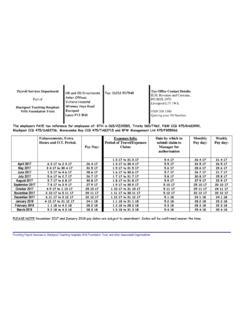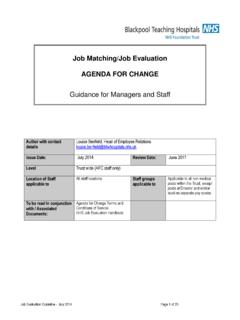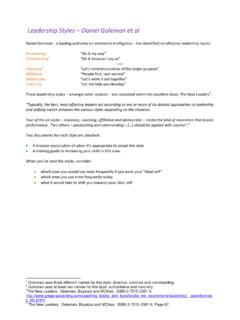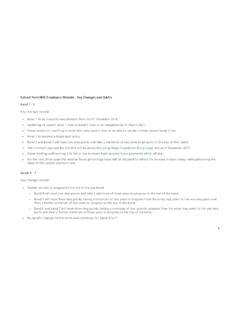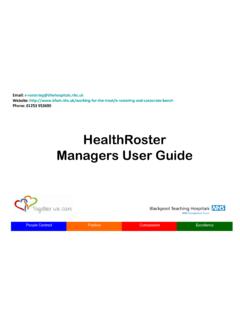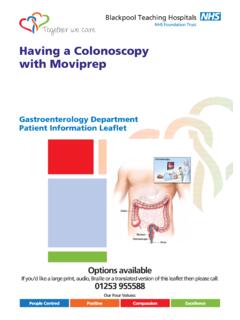Transcription of Advice for patients having Open-Heart surgery
1 Page 1 Patient Information For You Cardiac DivisionAdvice for patients having Open-Heart surgeryOptions available If you d like a large print, audio, Braille or a translated version of this leaflet then please call: 01253 955588 People CentredExcellenceCompassionPositiveOur Four Values:Page 2 Page 3 Contents Page1. Introduction - Advice for patients having open heart surgery 52. surgery for coronary artery disease 63. surgery for heart valve disease 74. surgery for aortic disease 75. heart surgery - the risks 76.
2 Prior to your operation 97. The anaesthetist 98. In the operating theatre 119. After the operation 11 10. The cardiac intensive care unit (citu) 11 Visiting in the cardiac intensive care unit 12 Length of stay 12 Patient s property 1211. Back on the ward after the operation 1212. Bathing and showering 1313. Caring for a surgical wound 13 Dressings 13 Problems with wound healing 14 Stitches, clips and staples 15 Taking care of stitches 1514. Going home 1515. Recovery 1616.
3 Returning home 17 First week at home 18 Second week at home 18 Third week at home 18 Fourth week at home 19 Weeks five / six 19 After six weeks 19 After eight weeks 1917. Do s and don ts 1918. Return to work 2019. Holidays 2020. Driving 2021. Sex 2022. Anticoagulants 2123. Outpatient appointment 2124. Cardiac rehabilitation 21 Page 4 How do we join the programme 2125. The cardiac rehabilitation occupational therapist role (OT) 2226. Dental Advice 2227. patients who were on treatment for high blood pressure before surgery 2228.
4 patients who were on water tablets before surgery 2229. Sleep and rest 2230. Pain 2231. Constipation 2331. Medications 23 Antiplatelets 23 Ace inhibitors 24 Angiotensin ii antagonists 24 Beta Blockers 24 Lipid-lowering drugs 24 Diuretics 24 Anticoagulants 25 Anti-arrhythmics 2533. Healthy eating 25 Fat 25 Saturated fat 25 Monounsaturated fat 25 Polyunsaturated fat 26 Carbohydrate 26 Fibre 26 Sugar 27 Alcohol 27 Body weight 28 Salt 28 Cholesterol 2834.
5 Smoking 2835. Stress 2936. Exercise 30 Exercise after 6-8 weeks cardiovascular 31 Type of exercise 31 Benefits of regular exercise 3237. Patient telephone helplines and websites 33 Page 51. Introduction - Advice for patients having open heart surgeryThis booklet has been compiled to offer information, Advice and reassurance to you and your family both before and after your heart surgery . The nursing staff are always available to answer any queries or help with any have been advised to have Open-Heart surgery , either to replace one or more of the heart valves or to have coronary artery bypass grafts (CABG), or both.
6 This is to improve your quality of life and relieve some of your Consultant will already have explained the risks associated with your operation when he saw you in clinic, or on the ward. If you or your family require any further information please ask to speak to your Nursing staff or one of the Doctors caring for you have a problem and are unsure what to do or you wish to speak to someone concerning your recovery, you can contact the Patient Care 01253 957718 (office) or through the main hospital switchboard on 01253 300000 and ask for bleep 825.
7 Page 62. surgery for coronary artery diseaseCoronary arteries are the blood vessels which carry blood to supply the muscle of the heart with oxygen, its source of energy. There are 3 main arteries: Right Coronary Artery. Left Anterior Descending Artery. Circumflex Artery. Coronary arteries can become narrowed or blocked, by the build up of a fatty substance in their walls. When the blockage is severe it causes chest pain, as the blood supply to the heart muscle is bypass surgery is commonly known as open heart surgery (the chest is opened, but not the heart itself ) and is obviously a very serious operation.
8 Thankfully, modern techniques have made it a relatively common procedure that we do well and with safety. You will have a cut down the middle of your chest and the breast bone (sternum) will be divided. In many people we will use one or both arteries, which lie next to the sternum (the internal mammary arteries) for one or more of the bypass grafts. While one surgeon is working on the chest, another surgeon or theatre practitioner works on taking a length of vein (for the bypass) through a long cut on the inside of the leg or some may have several very small incisions if your surgeon is using the Endoscopic Vein Harvesting technique (EVH).
9 Alternatively, the radial artery from the forearm may be used for a bypass. The radial artery appears to be at least as good as a piece of vein from the leg, and may even be better. However, it is not suitable or appropriate to use the radial artery in everyone. The coronary arteries on the surface of the heart are between 1mm and 3mm in diameter. The surgeon will sew (by hand) the vein from your leg and the mammary arteries to the narrowed arteries on your heart. With the heart beating many times a minute, this is not an easy job!
10 We will therefore stop your heart for a short time to allow us to do this part of the operation, but we will continue to pump blood around your body (even though the heart has been stopped) by using a bypass machine (heart-lung machine). The heart is usually stopped for between ten and ninety minutes depending on what needs to be done. After we have completed the bypass grafts we will start the heart beating again and remove you from the bypass machine so that your heart is pumping all the blood around your body once more.
